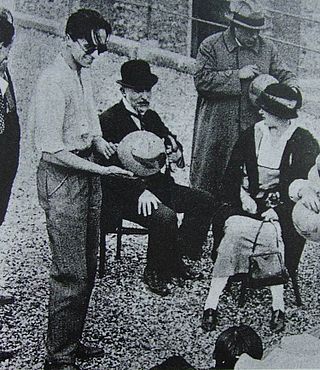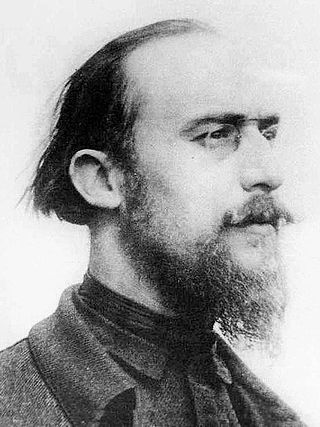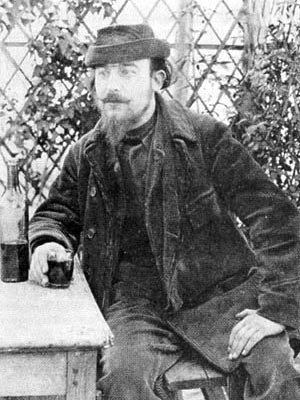Related Research Articles

Eric Alfred Leslie Satie, who signed his name Erik Satie after 1884, was a French composer and pianist. He was the son of a French father and a British mother. He studied at the Paris Conservatoire, but was an undistinguished student and obtained no diploma. In the 1880s he worked as a pianist in café-cabaret in Montmartre, Paris, and began composing works, mostly for solo piano, such as his Gymnopédies and Gnossiennes. He also wrote music for a Rosicrucian sect to which he was briefly attached.

Francis Picabia was a French avant-garde painter, writer, filmmaker, magazine publisher, poet, and typographist closely associated with Dada.

Roger Désormière was a French conductor. He was an enthusiastic champion of contemporary composers, but also conducted performances of early eighteenth century French music.
Entr'acte means 'between the acts'. It can mean a pause between two parts of a stage production, synonymous to an intermission, but it more often indicates a piece of music performed between acts of a theatrical production.

Parade is a ballet choreographed by Leonide Massine, with music by Erik Satie and a one-act scenario by Jean Cocteau. The ballet was composed in 1916–17 for Sergei Diaghilev's Ballets Russes. The ballet premiered on Friday, May 18, 1917, at the Théâtre du Châtelet in Paris, with costumes and sets designed by Pablo Picasso, choreography by Léonide Massine, and the orchestra conducted by Ernest Ansermet.

René Clair, born René-Lucien Chomette, was a French filmmaker and writer. He first established his reputation in the 1920s as a director of silent films in which comedy was often mingled with fantasy. He went on to make some of the most innovative early sound films in France, before going abroad to work in the UK and USA for more than a decade. Returning to France after World War II, he continued to make films that were characterised by their elegance and wit, often presenting a nostalgic view of French life in earlier years. He was elected to the Académie Française in 1960. Clair's best known films include Un chapeau de paille d'Italie, Sous les toits de Paris, Le Million (1931), À nous la liberté (1931), I Married a Witch (1942), and And Then There Were None (1945).

The Théâtre des Champs-Élysées is an entertainment venue standing at 15 avenue Montaigne in Paris. It is situated near Avenue des Champs-Élysées, from which it takes its name. Its eponymous main hall may seat up to 1,905 people, while the smaller Comédie and Studio des Champs-Élysées above the latter may seat 601 and 230 people respectively.
Furniture music, or in French musique d’ameublement, is background music originally played by live performers. The term was coined by Erik Satie in 1917.
Surrealist music is music which uses unexpected juxtapositions and other surrealist techniques. Discussing Theodor W. Adorno, Max Paddison defines surrealist music as that which "juxtaposes its historically devalued fragments in a montage-like manner which enables them to yield up new meanings within a new aesthetic unity", though Lloyd Whitesell says this is Paddison's gloss of the term. Anne LeBaron cites automatism, including improvisation, and collage as the primary techniques of musical surrealism. According to Whitesell, Paddison quotes Adorno's 1930 essay "Reaktion und Fortschritt" as saying "Insofar as surrealist composing makes use of devalued means, it uses these as devalued means, and wins its form from the 'scandal' produced when the dead suddenly spring up among the living."
Moses Pendleton is a choreographer, dancer and the artistic director of MOMIX. MOMIX is a dance company that he formed in 1981 as an offshoot of the Pilobolus, which he had co-founded while a senior at Dartmouth College in 1971. He remained a full-time member with the company until 1980. He choreographs dance sculptures that bring together acrobatics, gymnastics, mime, props, and film.

Entr'acte is a silent French Dada short film directed by René Clair. It premiered on 4 December 1924 at the Théâtre des Champs-Élysées in Paris as a prologue and entr'acte for the Ballets Suédois production of Relâche, based on a book by Francis Picabia, which had settings by Picabia, was produced by Rolf de Maré, and was choreographed by Jean Börlin. The music for both the ballet and the film was composed by Erik Satie.

The Ballets Suédois was a predominantly Swedish dance ensemble based in Paris that, under the direction of Rolf de Maré (1888–1964), performed throughout Europe and the United States between 1920 and 1925, rightfully earning the reputation as a "synthesis of modern art".
Relâche is French for "cancellation", "theater dark", or "no performance today". It may refer to:

Jack in the Box is a work written by Erik Satie in 1899 for a pantomime-ballet to a scenario by the illustrator Jules Depaquit. Satie gave it an English title because English phrases were considered fashionable in Parisian society at the time.

Non-narrative film is an aesthetic of cinematic film that does not narrate, or relate "an event, whether real or imaginary". It is usually a form of art film or experimental film, not made for mass entertainment.

The Shagreen Bone Op. 37-38 (1990) is a full-length ballet in three acts and an opera entr'acte in one act by Yuri Khanon, to a libretto by the composer based on Balzac's 1831 novel The Shagreen Skin.

Mercure is a 1924 ballet with music by Erik Satie. The original décor and costumes were designed by Pablo Picasso and the choreography was by Léonide Massine, who also danced the title role. Subtitled "Plastic Poses in Three Tableaux", it was an important link between Picasso's Neoclassical and Surrealist phases and has been described as a "painter's ballet".

The Pièces froides are two sets of piano pieces composed in March 1897 by Erik Satie. Unpublished until 1912, they marked Satie's break from the mystical-religious music of his "Rosicrucian" period (1891–95), and were a harbinger of his humoristic piano suites of the 1910s.
Jean Börlin was a Swedish dancer and choreographer, who was born in Härnösand on 13 March 1893, and who died in New York on 6 December 1930. He worked with Michel Fokine, who was his teacher in Stockholm.

Edith Helena von Bonsdorff was a Danish-Finnish ballet dancer and choreographer.
References
- ↑ Filmsdefrance, Entr'acte, James Travers